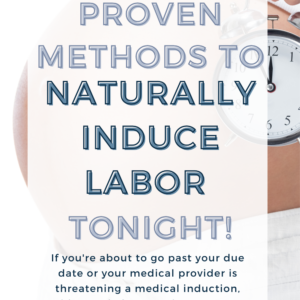Do you want a natural birth but are scared? You’ve never done it before. You’ve probably heard horror stories. And most women get epidurals. That leaves you constantly wondering, “How does a contraction feel”?? This post will help you dissolve your fears and help empower your labor, so you can have the natural birth you want.

If you’re reading this, that probably means you’re pregnant. Yay! Congrats!
It also means you’ve come to the realization that a lot of other expecting moms come to. How in the world am I going to get this baby out of my body?
The thought is scary. The world doesn’t set moms up to feel empowered or confident when it comes to birth. Movies scenes show laboring moms screaming through contractions in immense pain. Your friends probably have told you horror stories about the pain or deciding just to get an epidural before having too many contractions. And your doctor probably hasn’t told you anything. Nothing about how does a contraction feel, pain relief or any coping mechanisms.
Natural birth moms are set up for failure.
The truth about labor is it isn’t scary and you are totally capable of having a natural birth. After all, it’s what your body was literally designed to do and women have been having unmedicated natural deliveries for years.
You can do this. And here’s how.
Contractions 101
You’ve undoubtedly heard people refer to them as pains or labor pains. But that gives labor and contractions a negative and scary association. From now on, refer to them as contractions,
Before you know what a contraction feels like, you should know what it is and what it does. Education is power!
What is a Contraction?

Contractions are the tightening sensation you feel during labor. It’s how your body works to move baby down through the birth canal and out of your body.
Doesn’t it seem like such a mystery how a newborn baby is going to fit through your vagina?!
Contractions make that happen. You’ve heard about dilation and how you’ll need to be 10 centimeters dilated before baby can arrive. That dilation doesn’t happen on it’s own! It’s from the uterus contracting and flexing.
The uterus is one of the biggest muscles in the female body! It connects to the cervix, which is like a small doorway. As your uterus tightens and flexes, it starts the top of your belly and works down. It tightens and pulls until it reaches all the way down toward the cervix where it opens and dilates a little.
Then you get a rest and it happens again. Each contraction opens the cervix a little more until you’re 10 centimeters!
Related: The Right Way to Time Labor Contractions
How Long Does a Contraction Last?
Contractions will go on your whole labor and birth. In fact, you may even feel contractions as early as 20 weeks as your body practices for delivery with prodromal labor.
Related: Real Labor vs False Labor – How to Know the Difference
Even though contractions will go on your whole labor, how long they last changes as labor goes on. In early labor, a contraction only lasts a few seconds, like 10-20 seconds. They get longer and longer until right before pushing where they can last anywhere from 1 – 2 minutes.
What Does a Contraction Feel?

Most mamas who are wondering “what does a contraction feel like” are talking about contractions that happen during labor, not prodromal (false) labor.
Here’s a truth bomb – even though you’re given a ‘due date’ – baby comes when baby’s ready. That can mean anywhere from 37-42 weeks. Labor doesn’t follow a schedule or due date.
It does follow a series of stages, though, once you start and progress through labor. In terms of contractions, you’ll notice the intensity, duration and frequency change in the different stages:
- Early Labor
- Active Labor
- Transition
- Pushing
- Placenta delivery
- Postpartum
Once this process starts, it will be over in anywhere from a few hours to a few days. 7 stages of contractions seems like a lot! A few hours to a few days seems like a long time!
Fear not!
The strength and length of a contraction changes. They start off short and mild and only gain intensity and duration once you get to transition, and then they lessen and slow down again. You can totally manage that!
Early Labor Contractions
Early labor is referred to as the excited emotional signpost. You think labor has begun and you’re feeling a little bit of aching or twinging. But you aren’t super sure if it’s a real contraction. Either way – you’re excited and ready to conquer natural birth and meet you’re baby!
In medical terms, early labor is typically defined as the time when you dilate from 0-4 centimeters.
Contractions get stronger the harder they need to work for dilation and effacement. In this early stage of labor, dilating from 0-6 centimeters is kind of easy. Think about it. In the last few weeks of pregnancy, if you had a cervical check, it’s like you’re already at least a little bit dilated and a little bit effaced.
Since dilating to 6 centimeters doesn’t require your uterus to work as hard as when you’re going from, say, 7-10 centimeters, they’re less intense. This is great news because early labor is the longest stage of labor, lasting several hours.
How Does a Contraction Feel in Early Labor
Early labor contractions will begin feeling like a dull ache. As labor progresses, they’ll turn into mild and then more strong period cramps.
At the beginning of early labor, you may not even notice these contractions. Or you notice them a bit but aren’t really sure what it is or if they’re real.
Typically, they start at the top of your uterus and work their way down. You may also feel them wrap around to your back or mainly feel them in your back depending on how baby’s positioned.
There are no sharp, sudden pains in labor. Contractions start mild and build in intensity. The peak of intensity is where the contraction really tightens down to the cervix to open and thin it. After some cervical progress is made, the contraction lessens and lessens until you get a break.
This is the beautify of labor, contractions and labor. After every bit of hard work, you get a rest.
By the end of early labor, when your contractions become more intense like a strong period cramp, you’ll move into the acceptance emotional signpost. You’ve accepted that labor is going to require your attention. You’re confidence and ready.
As you near 6 centimeters and move into the serious emotional signpost, you’re in active labor.
Active Labor
Active labor is the part of labor where your cervix dilates from 6-8 centimeters. Contractions have taken on a consistent pattern and have increased in intensity.
This stage of labor can also take several hours. The good news is though it doesn’t last nearly as long as early labor! It also can vary. For example, if this isn’t your first labor, this stage can go faster since your body already knows what to do.
No matter what pregnancy or labor this is for you, active labor moves you into the serious emotional signpost.
How Does a Contraction Feel in Active Labor
Active labor is considered the serious signpost because contractions take all of your focus. You get down to business and get really serious about your body and every contraction.
This is when your birth education and relaxation practice really comes into play. In the Natural Birth Bundle, you’ll learn many relaxation and coping techniques for this stage and all stages of labor.
All of your energy will go toward coping during every contraction. You’ll lose your modesty and instead focus on comfort. This is when you’ll need to communicate to your husband or doula how you need your birth environment to change to support your focus and relaxation.
Contractions need to work harder during this stage or open your cervix all the way up to 8 centimeters. That means they’ll be stronger, last longer and be more intense than early labor.
Contractions during this time still begin like a really strong period cramp. As the quickly build intensity, it will feel more like if you’ve ever had a leg or muscle cramp. They’ll last about 60 seconds and then you’ll get a break.
These contractions are stronger than before, but you’re still handling them. You find a comfortable labor position. You limit distractions, and you rest during your break, drinking and eating to keep up your energy.
As you reach 7 centimeters, you’ll move into the next emotional signpost and contraction intensity.

Transition
Transition is the period of time you dilate from 8-10 centimeters. By the end of this phase, your cervix will be completely dilated and effaced and you’ll soon meet your baby!
This is the very shortest part of labor! Again, it varies from mom to mom. But it can last anywhere from a few minutes to about an hour.
It’s the beauty of nature’s design that this is the shortest stage of labor because it is the hardest.
To be perfectly honest, this is the stage of labor most natural mamas give up and get an epidural. It’s not because they couldn’t do it, it’s because they didn’t practice relaxation and focus techniques, educate themselves or prepare for natural labor.
As a natural mama, there are a few really important things you need to know about transition before going into labor:
How Does a Contraction Feel During Transition
Contractions do change a bit in transition.
Dilating from 8-10 centimeters takes a lot of work. This is a large opening, about the size of a donut. It takes extra effort from your contractions to make your sure your cervix is complete (10 cm dilated and 100% effaced).
Contractions get down to business here. They don’t become that much harder or intense. However, they typically do become irregular.
They go from being a consistent, 60-90 seconds with a minute or so break to more irregular.
Contractions may be:
- Closer to two minutes long
- Two right in a row with no break in between
- Less time to rest in between contractions
- One contraction with two different peaks
These are ways contractions can change. That doesn’t mean you will experience all or any of these. It also doesn’t mean that every contraction during transition will be like this.
But you can do this! The intensity of each contraction doesn’t actually get that much harder.
What changes the most is your mentality.
Self-Doubt Signpost in Transition
At this point in labor, you’ve been laboring for a while. Laboring anywhere from several hours to a few days is really exhausting.
You’re physically drained. You’ve not eaten a lot to refuel and nourish your body to keep laboring. You probably haven’t slept in a while. And even though contractions have changed a bit, the biggest change you’ll notice is your mentality.
During transition is when you hit the self-doubt emotional signpost. You aren’t sure if you can do it any more. You may start to freak out and get scared.
Labor is long and tiring. What if you can’t do it. How much longer could labor last? An epidural isn’t that bad, right?!
Just remember – as soon as you start having these thoughts during labor, remind yourself that these thoughts mean you’re in transition. It will be so soon where you’ll be push, meet your baby and it will all be over!
Transition only lasts a few minutes to about an hour. And if this isn’t your first baby, it will be so fast.
How Does a Contraction Feel with an Epidural
A majority of moms choose an epidural for pain management during labor and delivery. Depending on how strong the epidural is, you won’t feel contractions at all. Or you may just feel them lightly.
An epidural typically causes moms to feel very comfortable and relaxed that they sleep through a lot of labor and even transition.
This sounds really dreamy, but there are a lot of drawbacks to epidurals that all moms should consider.
Related: 9 Dissapointing Truths about Epidurals
Pushing Contractions
A lot of moms feel concerned about having the energy and strength to push after going through labor. Pushing is such a relief and actually feels GOOD to work with your body and contractions.
Contractions at this point will last about 2-3 minutes with a rest of about 2-3 minutes. When you’re cervix is complete and baby is ready for delivery, you will feel the urge to push. Unmedicated mamas typically don’t need much pushing guidance.
Rather than noticing the contractions at this stage of labor, you’ll probably pay more attention to the pushing sensation. It will feel like tons of pressure and weight in your vagina and butt. (A lot like when you REALLY have to go to the bathroom!)
When a contraction starts, you will push into that pressure and down into your bottom, like pooping, to help move your baby down and out the birth canal.
This stage only lasts 15 minutes to about an hour depending on if this is your first baby and if you start pushing only when your body’s ready.
Once baby’s in your arms, labor is mostly over! The hard parts are over, anyway.
Placenta Delivery
The huge organ and life line baby’s been attached to still needs to be delivered – it won’t just fall out.
Delivering the placenta feel like delivering a big bowl of warm Jell-O. It’s squishy, warm, wobbly and slippery. Once the umbilical cord stops pulsating and is cut, the placenta typically gets the idea that birth has happened, and it’s job is over.
It will begin to detach from the uterine wall. Your body will continue to have small contractions to help the placenta detach and be delivered. Not to worry! These contractions are super mild and most mamas don’t even notice them, while they’re paying attention to baby.
This only takes about 15-45 minutes. Sometimes, though, the placenta takes longer to detach and deliver.
Some HCP, especially in a hospital setting, will choose to go up into the uterus and detach it themselves or help the process along by tugging on the umbilical cord. This process is pinchy and uncomfortable.
You should talk to your HCP before L&D to specify your preferences for this.
Related: 10 Critical Questions to Ask your HCP for Natural Birth
Once the placenta is out, you’re officially on to the last stage of labor
Postpartum Contractions
Even though labor and delivery is complete, the first 1-2 hours postpartum is considered the fourth stage of labor.
Your uterus grew a ton during pregnancy! It now will start shrinking back down to normal, pre-pregnancy size. Postpartum contractions help this process along.
These contractions are really mild and feel a lot like a strong period cramp. You’ll even notice these contractions intermittently the first few days following delivery. Breastfeeding moms notice them a lot during nursing.
Nursing releases hormones that signal to your body that baby’s been born and is nursing, so the uterus can contract, heal and return to normal size.
This is one of the reasons that breastfeeding moms typically heal faster than non-nursing mamas.
How Painful are Contractions?
Now that you have an understanding of how does a contraction feel during each part of labor, you still may have a lingering question.
But how painful are contractions?!
The truth is – it depends.
The thing that’s so interesting is that the mom who reports contractions to be overwhelming, unbearable and intense who ends up getting an epidural feels the same strength and intensity of contractions as the mom who goes unmedicated, has peaceful and enjoyable delivery and liked her birth.
Contractions don’t choose a group of moms to be more intense for and a group to be easy for.
So what’s the difference?
The biggest differences are:
- Education – The more you know about the stages of labor and delivery and what to expect during L&D, the better. You’ll understand what’s going on with your body
- Preparation – Birth education and knowing how labor and delivery works is super important. The second biggest importance is knowing how to relax and focus during contractions. There are tons of mindful practices and techniques you can use to ease contractions and make them as east as possible.
- Mindset – Like most endurance activities, your mindset as the ability to make or break your natural birth. Unlike most endurance activities, your body was literally made for this! During labor, focus on positivity. Have your husband or doula give you constant reminders of your strength and ability, Rely on your birth affirmations. You can do this and you will.
The one thing these all have in common is you’re in control! Take matters into your own hands. Learn how to handle birth by educating yourself and having plenty of coping techniques available to use form the Natural Birth Bundle.











Leave a Reply